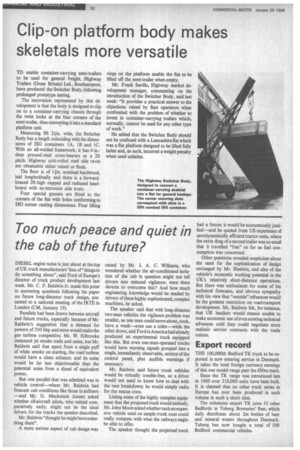Too much peace and quiet in the cab of the future?
Page 38

If you've noticed an error in this article please click here to report it so we can fix it.
DIESEL engine noise is just about at the top of UK truck manufacturers' lists of "things to do something about", said Ford of Europe's director of truck product development last week. Mr. C. F. Baldwin Jr. made this point in answering questions following his paper on future long-distance truck design, presented to a national meeting of the IRTE in London (CM, January 19).
Parallels had been drawn between aircraft and future trucks, especially because of Mr. Baldwin's suggestion that a demand for powers of 350 bhp and more would make the gas turbine competitive. Mr. W. Edbrooke instanced jet smoke trails and noise, but Mr. Baldwin said that apart from a single puff of white smoke on starting, the road turbine would have a clean exhaust; and its noise would be far less objectionable than the potential noise from a diesel of equivalent power.
But one parallel that was admitted was in vehicle control—where Mr. Baldwin had forecast cab conditions like those in airliners —and Mr. G. Mackenzie Junner asked whether ek-aircraft pilots, who retired comparatively early, might not be the ideal drivers for the trucks the speaker described.
Mr. Baldwin "thought he might have something there".
A more serious aspect of cab design was raised by Mr. J. A. C. Williams, who wondered whether the air-conditioned isolation of the cab in question might not lull drivers into reduced vigilance; were there devices to overcome this? And how much engineering knowledge would be needed by drivers of these highly sophisticated, complex machines, he asked.
The speaker said that with long-distance two-man vehicles the vigilance problem was smaller, as one man could move about, cook, have a wash—even use a toilet—while the other drove, and Ford in America had already produced an experimental truck equipped like this. But even one-man-operated trucks would have warning signals grouped into a single, immediately observable, section of the control panel, plus audible warnings if necessary.
Mr. Baldwin said future trunk vehicles would be virtually trouble-free, so a driver would not need to know how to deal with the rare breakdown; he would simply radio for the rescue crew.
Listing some of the highly complex equipment that the projected truck would embody, Mr. John Moon asked whether such an expensive vehicle used on simple trunk runs could really compete with what the railways might be able to offer.
The speaker thought the projected truck had a future; it would be economically justified—and he quoted from US experience of aerodynamically efficient tractor units, where the extra drag of a second trailer was so small that it travelled "free" so far as fuel consumption was concerned.
Other questions revealed scepticism about the need for the sophistication of design envisaged by Mr. Bladwin, and also of the vehicle's economic working potential in the UK's relatively short-distance operations. But there was enthusiasm for some of his technical forecasts, and obvious sympathy with his view that "outside" influences would be the greatest restriction on road transport development. Mr. Baldwin felt, for instance, that UK hauliers would remain unable to make economic use of even existing technical advances until they could negotiate more realistic service contracts with the trade unions.
Export record
THE 100,000th Bedford TK truck to be exported is now entering service in Denmark. It takes the total foreign currency earnings of this one model range past the £80m mark.
Since the TK range was introduced late in 1960 over 210,000 units have been built. It is claimed that no other truck series in Europe has ever been produced in such volume in such a short time.
The milestone export TK joins 52 other Bedfords in Tuborg Breweries' fleet, which daily distributes about 2m bottles of beer and mineral waters throughout Denmark. Tuborg has now bought a total of 500 Bedford commercial vehicles.












































































































